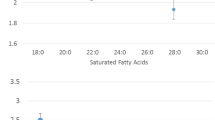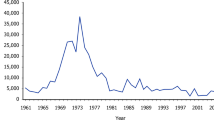Abstract
DURING an analysis of the lipids of the deep sea jellyfish Atolla, an unusually large percentage of phthalic acid was found in the fatty acids of the saponifiable fraction. The identification was based on gas liquid chromatographic (GLC) analysis on three columns (Table 1).
This is a preview of subscription content, access via your institution
Access options
Subscribe to this journal
Receive 51 print issues and online access
$199.00 per year
only $3.90 per issue
Buy this article
- Purchase on SpringerLink
- Instant access to full article PDF
Prices may be subject to local taxes which are calculated during checkout
Similar content being viewed by others
References
Ackman, R. G., and Hooper, S. N., Comp. Biochem. Physiol., 24, 549 (1968).
McLafferty, F. W., and Gohlke, R. S., Anal. Chem., 31, No. 12, 2076 (1959).
Author information
Authors and Affiliations
Rights and permissions
About this article
Cite this article
MORRIS, R. Phthalic Acid in the Deep Sea Jellyfish Atolla. Nature 227, 1264 (1970). https://doi.org/10.1038/2271264a0
Received:
Issue date:
DOI: https://doi.org/10.1038/2271264a0
This article is cited by
-
Investigation of the antifouling constituents from the brown alga Sargassum muticum (Yendo) Fensholt
Journal of Applied Phycology (2009)
-
Quantitative analysis of the early changes of hepatocyte nuclei after treating Syrian golden hamsters with Di(2-ethylhexyl)phthalate
Journal of Cancer Research and Clinical Oncology (1986)
-
Effects of Di-n-butyl and Di-2-ethylhexyl phthalate on the eggs of ring doves
Bulletin of Environmental Contamination and Toxicology (1974)
-
Toxicity of phthalate esters to nervous tissue in culture
Bulletin of Environmental Contamination and Toxicology (1974)
-
Phthalate Esters as Environmental Contaminants
Nature (1972)



